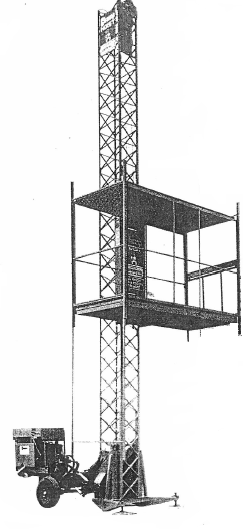OSHA recently released a report describing an incident in which a material hoist collapsed, killing a 37-year-old man.
The report highlights a lack of safety training and inadequate inspecting as leading causes of the accident.
What Happened
Three workers were adding a tower section to a material hoist, which their company had rented. One of the workers operated the hoist’s carriage motor, while the other two rode on top of the carriage car to the ninth tower section to add a tenth tower. Both workers on the carriage wore body harnesses and connected their lanyards to the hoist’s gin pole.
 When they arrived at the ninth tower, one of them disconnected from the gin pole and hooked onto a lifeline anchored to a steel beam on the roof of the building their company was working on.
When they arrived at the ninth tower, one of them disconnected from the gin pole and hooked onto a lifeline anchored to a steel beam on the roof of the building their company was working on.
They felt the carriage assembly drop slightly, but they we so focused on their work that they didn’t stop what they were doing.
Then two critical safety measures failed: the safety chain connecting the carriage assembly to the tower broke completely, and the safety brakes didn’t engage to stop the carriage from falling.
The carriage dropped 90 feet to the ground, causing the gin pole to break. The worker still connected to it plunged to his death.
How It Could Have Been Prevented
OSHA’s incident investigation found multiple safety issues:
- Even though the material hoist was rented from a rental yard where it had sat idle for about a year, it wasn’t inspected before use.
- Workers weren’t given sufficient training in how to erect a material hoist for safe use. (The safety chain wasn't welded together at the hoist’s eyebolt connection; instead, it was simply wrapped around the tower leg each time the carriage stopped at a tower.)

- Workers connected their fall-protection equipment to the gin pole.
- Workers rode on top of the carriage.
- The brake system that didn’t engage wasn’t properly installed.
OSHA offers straightforward conclusions about how this accident could have been prevented. Their advice boils down to training and inspecting. This accident probably wouldn’t have happened if either of those had been adequate.
Instead, the workers weren’t taught how to install or use the material hoist safely, or if they were, they weren’t taught that safety matters. And, inexplicably, rented equipment was used without checking it first to ensure its safety.
Takeaway Point
Preventing tragedies and the high cost of workplace accidents requires a combination of strong safety training and diligent pre-use inspections.
To read the full OSHA report, click here.
Images courtesy of OSHA.












